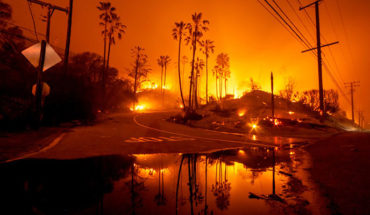More than half a century ago, Daniel Patrick Moynihan, then an adviser to President Richard Nixon, wrote a memo describing a troubling future caused by what he called “the carbon dioxide problem.”
In his text he explained that the increase of this gas in the atmosphere as a result of the burning of fossil fuels would heat the planet dangerously, melt glaciers and cause sea level rise.
Now, 53 years after that Moynihan memo, President Joe Biden on Tuesday signed the most important law approved in the United States against climate change, which it contemplates the largest investment in the history of that country to combat this scourge: some US $ 369,000 million.
The regulation is part of a broader $700 billion package that also includes measures related to health care and improving tax collection.
BBC Mundo tells you 4 keys to this new law that, according to experts, could give an important boost to the fight against climate change in the United States.
1. A significant (albeit insufficient) reduction in CO2 emissions
According to the authors of the new legislation, this reduce U.S. carbon emissions by 40% below 2005 levels by 2030.
The United States is looking for ways to combat climate change while suffering from persistent droughts.
That’s well below the 50-52% cut promised by the president. Joe Biden last year, but the fact that the U.S. can make a big effort to achieve that goal is seen as a victory by many in the Democratic Party, who consider this to be a great first step after decades of inaction..
“That was part of the promises for 2030 coming from around the world that Climate Action Tracker experts suggested would put the planet on track for 2.4°C of warming this century. At first glance, if the US is not able to meet the promised total cut of 50-52%, it seems difficult to reach less than 2.4°C.” Matt McGrath, BBC Environment Correspondent.
“It bears repeating that this is well above the 1.5°C threshold of warming, compared to pre-industrial levels, which scientists say is critical to avoiding very dangerous impacts, he adds.
2. Billions in incentives
The law provides for the investment of almost US $ 400,000 million in a decade in tax incentives that seek to guide consumers towards the adoption of electric vehicles and give a boost to electricity companies to accelerate the step towards the adoption of renewable energy sources such as solar and / or wind.
The new law establishes incentives for the purchase of electric cars.
In the past, attempts to reduce emissions from fossil fuel-fired power plants have been hampered by U.S. courts, which is why this time the Biden administration opted for a proven approach: putting money in the hands of citizens.
Like this consumers will receive tax incentives of up to $7,500 for the purchase of new electric cars and up to $4,000 when it comes to used electric vehicles.
Some experts, however, have warned that this measure may not be as useful because the high price of these cars in the United States makes them inaccessible to the average consumer and because, given the current market conditions – high demand with low production – manufacturers have no incentive to reduce prices.
The law also provides incentives to heat homes with heat pumps and even to prepare their food using electric induction cookers.
The package also contemplates US$30 billion to boost the production of solar panels, wind turbines and batteries, as well as US$10 billion for the construction of factories for the production of electric cars and solar panels.
Measures are also envisaged to help the most vulnerable communities. For example, they will allocate $60 billion to support disadvantaged areas that are most affected by climate change. This amount includes $27 billion for the creation of a national bank that will finance investments in clean energy projects, especially in poor communities.
3. A law without bipartisan support
EPThe package of measures approved by Congress – under the name of the “Inflation Reduction Act” – is actually the result of a huge reduction of the much more ambitious $3.5 trillion proposal that Biden wanted.
Vice President Kamala Harris’ vote was key to the passage of this bill in the Senate.
To reach this reduced version required numerous cuts and resignations, as well as long months of negotiations, despite which the rule was approved in the Upper House with a vote 51-50, which means that it did not obtain the support of any Republican senator and that, to break the 50-50 tie needed the vote of Vice President Kamala Harris in her capacity as president of that chamber of Congress.
And yet, it was still very difficult to secure the votes of all democratic Party senators, especially Joe Manchin of West Virginia and Kyrsten Sinema of Arizona, whose endorsements were barely won in recent weeks and involved significant concessions and sacrifices.
In the case of the Republican Party, not only have they expressed their rejection of the rule, but some leaders of that party have pointed out that will try to stop or slow down your application.
Republican Senator Marco Rubio of Florida criticized the law, saying it is far from the interests of citizens because it will not help reduce the prices of products.
4. International impact
One of Biden’s election promises was to reincorporate the United States into the Paris Agreement on Climate Change and place that country in a leading position in this area.
China overtakes the U.S. as a greenhouse gas emitter.
The former he did by signing an executive order on his first day in the White House; the second is more difficult to achieve.
Experts agree that The U.S. faces a credibility problem in this field, because being one of the main CO2 emitting countries it is difficult to ask others to reduce their emissions.
As one Democratic Party senator has exemplified, “You can’t preach about sobriety from a bar stool.”
Therefore, it was very important that the emission reduction targets set by Biden on the occasion of the 2021 Climate Summit found a way to materialize.
Although this new package of measures will not be enough to achieve it, at least it constitutes a concrete advance that the White House will be able to exhibit.
What will be its impact on the world? At the moment it is difficult to know, among other things, because China – the world’s main emitter of greenhouse gases – decided to break off collaboration with the US in this field after the recent visit of the president of the US Congress, Nancy Pelosi, to Taiwan.
The package of measures will achieve a substantial reduction in CO2 emissions, although lower than Biden had promised.
“Climate was one of the few areas where relations between superpowers Eran positive. Without a level of trust and agreement between the two, the Paris climate agreement would never have been born,” said McGrath, the BBC’s environment correspondent.
“At last year’s COP26 meeting in Glasgow, cooperation between the two helped the talks make some progress. All of that is now in ruins and the side effects are unlikely to be positive,” he adds.
As for other large emitters such as India or Brazil, their governments are likely to focus on the fact that the emission reductions provided for in the new US law are below what Biden had promised.
Other Developing countries are also wondering where the resources that have been promised to them are. to tackle climate change.
“Although the U.S. bill provides $370 billion in climate spending, those of us in the South wonder why the U.S. and other rich countries have not kept their promise to collectively provide the $100 billion of climate finance to poor and vulnerable countries by 2020,” said Mohamed Adow, director of the Power Shift Africa think tank. who welcomed the progress represented by the bill.
Still, the new legislation means a breakthrough for both the U.S. and the world.
At the end of the day, in the words of Justin Rowlatt, the BBC’s climate editor: “With the US leading by example, there is hope that efforts will be reinvigorated. international to address global warming.”





